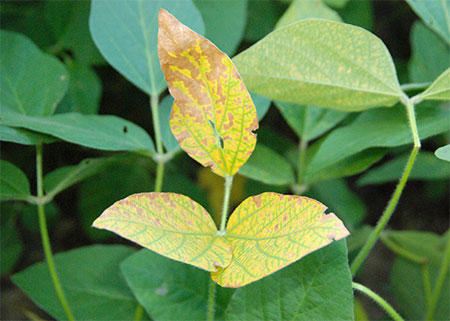News
The information presented on this page may be outdated. It may refer to situations which have changed or people who are no longer affiliated with the university. It is archived as part of Mississippi State University's history.
Extension, MAFES faculty identify soybean disease

Mississippi State University researchers have identified a new disease that has reduced yields in several soybean fields across the state in recent years.
12/18/2015
By: Robert Nathan Gregory
Researchers established the uniqueness of this fungus-based disease and have named it "soybean taproot decline." It has symptoms similar to some other soybean diseases, including the yellowing of leaves while the veins stay green. Unlike other diseases that affect the crop during specific times in the growing season, soybean taproot decline is something producers will have to watch for year-round.
"This disease has eluded all of us, and I think the reason for that is it has been misdiagnosed as a number of similar diseases we have seen before in soybean, such as sudden death syndrome," said Tom Allen, MSU Extension Service plant pathologist and Mississippi Agricultural and Forestry Experiment Station researcher. "It's not on a single fungicide label, and it has never been reported as an issue in soybeans. I've been looking at this ever since I got here in 2007."
Allen and Experiment Station researcher Maria Tomaso-Peterson have worked together to determine that soybean taproot decline can be spotted during the vegetative stage of soybean growth, when the plants emerge and begin developing leaves.
"If you grab a soybean plant and pull it out of the ground, and you leave the vast majority of the taproot there, or you have a portion of the taproot and you break it, and it snaps and sounds dry, you have taproot decline," Allen said. "The organism that causes this essentially produces a dry rot and rots the taproot away. The base of the stem will look black, indicating fungal growth."
The researchers performed field trials to gauge the potential damage related to soybean taproot decline. Preliminary data suggested the average amount of yield loss caused by the fungus is about 18 percent of harvestable yield. However, their trials were conducted in small plots, and Allen said farmers may not see such heavy losses in large-scale production.
"As we looked at several fields across the state and conducted trials of our own, it became evident that this disease has the potential to be a significant yield reducer if allowed to go undetected," Allen said. "There are severe cases that we're observing in some instances, but it is not yet a major issue in general. Not every field where taproot decline occurs is going to have an 18 percent yield reduction. I would say most fields that have this particular disease would have minimal amounts of yield reduction as a result."
Allen said MSU faculty will continue to conduct field trials along with greenhouse and laboratory research in collaboration with colleagues in Arkansas and Louisiana.
"At present, the most important step is determining what organism is causing taproot decline," he said. "Once the organism has been identified, full-scale field trials can be initiated to attempt to manage the disease and reduce the yield losses associated with the organism."
View More News